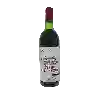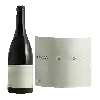
Château de MarmorièresSans Sulfites Ajoutes Rouge
This wine is a blend of 3 varietals which are the Marselan, the Mourvèdre and the Merlot.
In the mouth this red wine is a powerful with a nice balance between acidity and tannins.
This wine generally goes well with beef, veal or pasta.
Taste structure of the Sans Sulfites Ajoutes Rouge from the Château de Marmorières
Light | Bold | |
Smooth | Tannic | |
Dry | Sweet | |
Soft | Acidic |
In the mouth the Sans Sulfites Ajoutes Rouge of Château de Marmorières in the region of Languedoc-Roussillon is a powerful with a nice balance between acidity and tannins.
Food and wine pairings with Sans Sulfites Ajoutes Rouge
Pairings that work perfectly with Sans Sulfites Ajoutes Rouge
Original food and wine pairings with Sans Sulfites Ajoutes Rouge
The Sans Sulfites Ajoutes Rouge of Château de Marmorières matches generally quite well with dishes of beef, pasta or veal such as recipes of pork tongue with bacon and onions, saffron pasta with prawns or piccata with cheese.
Details and technical informations about Château de Marmorières's Sans Sulfites Ajoutes Rouge.
Discover the grape variety: Marselan
Marselan noir is a grape variety that originated in France (Languedoc). It produces a variety of grape specially used for wine making. It is rare to find this grape to eat on our tables. This variety of grape is characterized by large bunches and small grapes. Marselan noir can be found in several vineyards: South-West, Cognac, Bordeaux, Languedoc & Roussillon, Rhone valley, Provence & Corsica, Loire valley, Savoie & Bugey, Beaujolais.
Last vintages of this wine
The best vintages of Sans Sulfites Ajoutes Rouge from Château de Marmorières are 0
Informations about the Château de Marmorières
The Château de Marmorières is one of of the world's great estates. It offers 31 wines for sale in the of Languedoc-Roussillon to come and discover on site or to buy online.
The wine region of Languedoc-Roussillon
Languedoc (formerly Coteaux du Languedoc) is a key appellation used in the Languedoc-Roussillon wine region of southern France. It covers Dry table wines of all three colors (red, white and rosé) from the entire region, but leaves Sweet and Sparkling wines to other more specialized appellations. About 75% of all Languedoc wines are red, with the remaining 25% split roughly down the middle between whites and rosés. The appellation covers most of the Languedoc region and almost a third of all the vineyards in France.
The word of the wine: Piccolo
Small bottle with a capacity of 20 centilitres.














